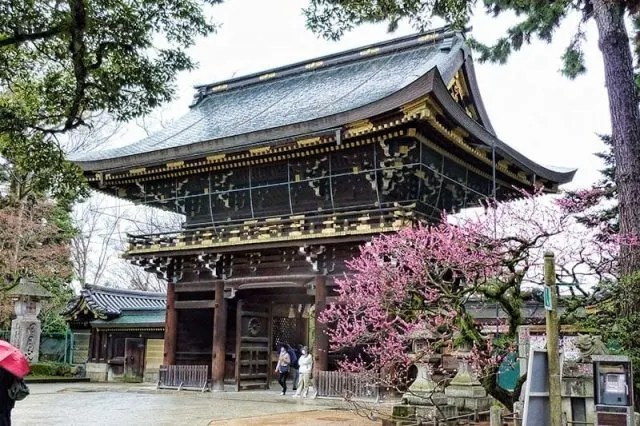Attending a traditional tea ceremony in Japan combines a longstanding cultural ritual and a unique food experience. The precision of the ceremony, the beautiful craftsmanship of the implements and tea room, the intense slightly bitter flavour of the tea offset with the sweetness of the confectionary come together to make this a fantastic addition to your itinerary.

Table of Contents
The origins of the tea ceremony in Japan
Japan’s top tea schools
There are many tea schools across Japan but the top three in order of size are Sen no Rikyū, Urasenke and Mushanokōjisenke. A ceremony conducted by someone trained in one of these will provide a top-rate experience. The ceremony conducted by each is very similar but there are tiny differences in the way they each perform it down to the size and detailing on the bamboo whisk they use.
I was interested to learn that in an effort to keep the tradition alive and popular amongst younger people in Japan the tea schools now hold lessons within the education system. There are tea clubs within high schools that students can join in a similar way to learning an instrument or playing a sport as an extra-curricular activity.
A few fun facts before you go
The cup
The cup, or bowl, that is used in a traditional ceremony is called the cha wan. It has no handles but has a design on one side, the front, and sometimes a smaller design on the back. When you are served your tea, the front is placed facing you so you may enjoy the detailing. When you lift it to drink you place it on your left hand and rotate it twice so the front design faces away from you. Your companions may now enjoy the design and you won’t be drinking directly from it.
The cha wan is usually hand made ceramic but they can be made of other materials including lacquered wood.
Whisked no stirred
Matcha is served in small quantities, usually only coming a quarter to a third of the way up the bowl. It is made with a powder of the whole tea leaf which creates a thicker more substantial drink.
A tiny bamboo ladle (cha shaku) of matcha powder is added to the hot water. Rather than stirring at this point, the tea master then takes a custom bamboo whisk (cha sen) and moves it in the tea bowl from front to back. At first the whisk moves slowly then speeds up to combine the powder thoroughly into the water which creates tiny bubbles. Those bubbles bring air into the mix allowing the flavour to develop.

A healthy treat
I lose track of whether the ‘experts’ are telling us that coffee is good for us this week or going to kill us but green tea by contrast has the medical profession almost universally in agreement that it’s a healthy addition to our diet and lifestyle.
Firstly there is the tea itself, it’s packed with antioxidants called polyphenols which have a beneficial effect on your metabolism, heart health and regulating blood pressure and sugar levels. Because you are ingesting the whole powdered leaf, rather than an infusion of the leaf, the health benefits of matcha are higher than other green teas.
Then there is the ritualistic benefit. The environment and precise controlled movements of the tea master, the controlled pace of receiving and consuming the sweet and tea are all very calm and meditative. It’s got to take your environmental stress levels down a notch or two.
Fun tea experiences to include in your Japan trip
Drinking tea prepared by a Geisha in Kyoto
One of the most preserved historical districts of Kyoto city is Gion and each spring the Geiko and Maiko of Gion perform a spring dance called the Miyako Odori. It takes place between the first and third weeks of April at the Minamiza Theatre.

The performance itself if beautiful but for an additional fee you can purchase a show and tea combo ticket where you are served a bowl of matcha and traditional spring-themed wagashi sweet before the show. A geisha performs the formal preparation using the elaborate utensils in front of you and the maiko delivers some of the tea bowls. It’s a delicious and fun experience.
Experience the home of green tea in Uji
The destination in Japan that many will associate with tea is Uji, located in Kyoto prefecture it’s about 20-minutes south of the city by train. Uji is a great spot for a day trip if you are staying in Osaka or Kyoto.
It’s a very picturesque spot located on the river and steeped in history, most significantly it’s home to the Byodoin temple, seen below and featured on the 10 yen coins.

As you walk through the town you can’t miss its connection to tea, you’ll see green tea noodles being prepared through restaurant windows, many tea shops, menus laden with tea-inspired dishes and it’s a good spot to stock up on good quality and appropriately sealed packets of matcha to bring home with.
An affordable tea ceremony experience in Nara
It’s no secret that we love the city of Nara. It an ancient capital of Japan with wild but mostly tame deer wandering the streets, some of the friendliest locals in the country and beautifully preserved heritage temples and shrines.

There are a couple of options for a tea ceremony in Nara but the visitors centre, not far from the train station offers a great value option at Y2000. The hosts have trained in one of the three top tea schools so you’ll be getting an authentic experience, they have a beautifully appointed tatami mat room where the ceremony is held and they speak perfect English so you can ask any questions you have about the tea, ceremony or city.
If closed borders are making you miss Japan as much as I am, then think about joining in on one of their online tea ceremony session to get you in the mood for some travel planning for the future. The online sessions are fun and free, you can sign up for the next one here.
‘Pop up’ tea houses during seasonal festivities
During many events there are small pop up tea rooms at many of sites, especially during spring and autumn special openings. These usually serve tea and some type of traditional sweet, some of these offer a tea service but most often they are just the tea experience in a beautiful environment. When these are outdoors the benches are brought out to sit on and topped with red cloths making it all a bit more special than grabbing a coffee to go.

A few we have enjoyed include Eikando temple in Kyoto during the fall leaves, in a heritage guest house where Emperor Meiji stayed in Nagahama during the bonbai festival, during a special spring opening at the Kyoto Imperial Palace and at the Golden Pavilion at a similar time of year.
Baikasai plum blossom festival at Kitano Tenmangu Shrine
A very few special events do include a tea ceremony, and the plum blossom festival at Kitano Tenmangu Shrine in the north of Kyoto city is one of these. The festival is known as Baikasai and is an outdoor tea ceremony called a nodate.

The Geiko and Maiko from the nearby Kamishichiken geisha district prepare and serve the tea and sweets to guests. Opportunities for the public to see geisha are rare, there are even fewer events where you may be served tea by them so this is worth considering if you will be in the city on the 25th of February.
Learn more about all of Kyoto’s geisha districts.
The geisha in their elegant colourful kimono and elaborate seasonal hair ornaments, a local festival in Kyoto to celebrate the plum blossom and a unique tea ceremony make this a day to remember.
In previous years the tea ceremony tickets have cost Y1500 and there are a capped number of tickets available.
Tokamachi Snow Festival
Another unique tea experience takes place at the Tokamachi snow festival in Niigata, around 2 hours by train from Tokyo Station. This one is less well known than the Sapporo snow festival in Hokkaido but is easier to access for many visitors. In addition to around 70 large snow sculptures, there is a tea component that is quite special here.
There is a tea garden sculpted from snow and young women in kimono serve bowls of steaming matcha and sweets as you sit on benches made of snow and tea masters demonstrate the elegant art of the traditional tea ceremony in front of you. You will need to queue a little for the experience but incredibly it’s free as most of the Tokamachi festival events are.
Booking tea ceremony experiences around Japan
Your first thought might be that a tea ceremony is something you need to do in Kyoto, and there certainly are plenty of opportunities in this historic city but other parts of the country also have a deep connection to the ritual and highly experienced tea masters conduct tea ceremonies all over.
In Kyoto
Kyoto is a great place to experience ‘the way of tea’ and this casual tea ceremony is a good choice for several reasons. The tea ceremony takes place at Jotokuji Temple a beautiful traditional temple complex in a tatami matted tea room that looks out to the temple gardens. The location is a 15-minute walk from Kyoto station or 7-minutes from the Gojo subway station exit making it very easy to coordinate into your day of sightseeing around the city.
The environment is crucial to the Japanese tea ceremony and this is one of the few that will greet you and take you through the garden and tea garden into the tatami matted tea room. The customs are explained in English and the ceremony for making the tea is demonstrated.
While the procedure and environment are authentic, participants are not required to dress specifically for the occasion which can be convenient if you are incorporating it into a day exploring the city. There is also the option of a low chair if sitting in the traditional way is uncomfortable for you.
A second Kyoto option is this tea experience near the Golden Pavillion. I’m particularly attracted to this one as the host is not only an expert in the ritual as a Urasenke tea master but also speaks excellent English and is able to explain the finer points of the ceremony, tools and significance of each step.
Again the location near the famous sightseeing spots of the Golden Pavillion and Ryoanji is very convenient to build into your itinerary.
In Tokyo
In Tokyo there are a variety of tea ceremonies to pick from. Many of the top hotels have these on-site in a dedicated tatami matted tea room like the Hotel New Otani which is one we regularly choose to stay at. While their tea room is located upstairs they do have a lovely garden to stroll in before or after your ceremony and the pricing is very reasonable.
Another interesting option that offers something a little different is a tea ceremony at the bonsai museum in Edogawa. The tea room has a view of the bonsai garden and you are able to take photos in the tea room and garden after the ceremony. Bonsai is another of the Zen arts so makes an interesting combination. You also have the option to add on wearing a yukata or kimono during your ceremony and photos at Shunka-en.
This one is a little more difficult to get to from the central city. It’s around 1.5 km from Mizue Station so you can take a bus, taxi or walk there from the station.
We highly recommend a tea ceremony as one of the must-do cultural and foodie experiences when travelling in Japan. Do you have one you would recommend? Or if you’re not a matcha fan what is your favourite type of Japanese tea?
If you found this article useful please consider saving it to Pinterest. It makes it easy for you to find it again, it helps us, and it helps other travellers to find the information they are looking for.



